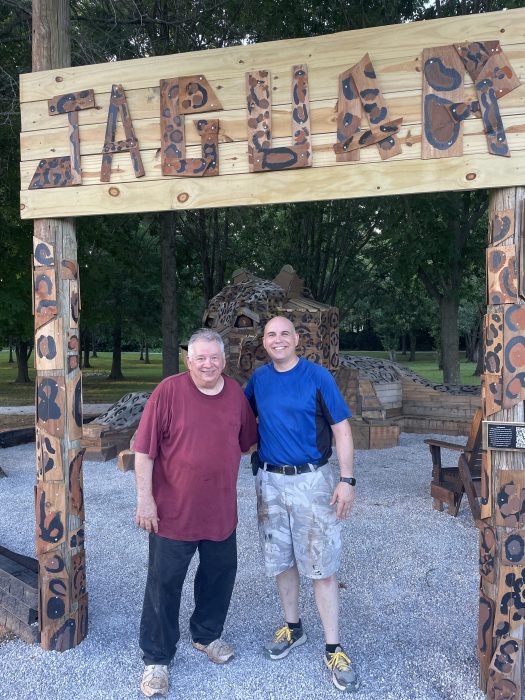Close to home: Medical community’s evolution means needs are met locally
Published 4:45 pm Thursday, September 13, 2012

- Greenview Regional Hospital in 1962. (Photo Courtesy of Greenview Regional Hospital)
It is rare that someone can say they can’t get any of their health care needs met in Bowling Green.
The city now has a myriad of general practitioners, specialists, dentists, orthodontists, mental health facilities – all hoping to help people get well closer to home without traveling to places such as Nashville and Louisville.
These are just some of the health care facilities available in Bowling Green.
Barren River District Health Department
Although Dennis Chaney has been district director at the Barren River District Health Department for only a decade, he has noticed that services have been going through a metamorphosis.
“It’s moving away from the delivery of personal individual health services to more of a focus on broad community issues,” he said. “We want to assure that folks in communities have access to preventative health care.”
Because funding for health public health services has changed, the types of services offered have changed. For example, in past years the health department had offered flu vaccines to the general public. This fall, it will provide them only for its staff and work sites where it had already been been giving the vaccines, Chaney said.
“Access is plentiful. When I came here 91⁄2 years ago, the health department and a few doctors were where you can get a shot. Now you can get them at small individual pharmacies and large pharmacies,” he said. “We’re also seeing a capacity for other immunizations provided. In some chain pharmacies, you can get some immunizations.”
The health department is looking at health data, particularly at chronic diseases, such as high blood pressure, diabetes and obesity.
“We will be doing more health activities educating on how to change behaviors, how to improve individual health. We’ll continue to transition to really focus in on data driving population health changes, the biggest being chronic disease issues challenging our area,” he said. “We will always provide individual care, but we will shift our focus more into the delivery of community health care.”
There will be programs – such as Cooper-Clayton smoking cessation classes, diabetes self-help managing classes and information about exercising and eating healthy foods – to help people with changing their overall health.
“We’re trying to encourage people not to smoke. We’re doing Cooper-Clayton, work with schools, work sites, (Bowling Green-Warren County) government to address smoke-free policies,” Chaney said. “Data has shown that smoking and secondhand smoke contributes to disease.”
The focus for health promotion is on schools, work sites and the faith community.
“They’re a captive audience. There’s so much focus on schools having the capacity to increase the nutrition content of school lunches, using candy as a reward and not taking minutes from recess for disciplinary issues,” he said. “We talk about health education, living tobacco-free lives and good health mind, body and spirit.”
Things haven’t totally changed at the health department. Family planning, sexually transmitted infection testing, adult health issues, well-child exams and the Department of Agriculture’s Women, Infants and Children food program are still available there.
“We know it’s more expensive to eat healthier. WIC now offers farmers market vouchers,” he said. “We’re excited because the region is so rich with fruits and vegetables.”
Because the health department also covers rural areas, certain services will still be available there, Chaney said.
“We will always do a varying degree of immunizations, probably more so in those rural areas where there are no pediatricians or a limited number of family practitioners,” he said.
Chaney is hopeful about the future of the health care industry.
“We’re seeing some improvements locally, statewide and nationally,” he said. “Leaders in the community are really aware of the challenge that poor health is to the local community.”
The Medical Center
The Medical Center started as the 35-bed City Hospital in 1926 and cost $130,000 to build – the equivalent of $1,561,300 today. The hospital, which was on Reservoir Hill, expanded over the years and became Bowling Green-Warren County Hospital in 1946. In 1976, the Certificate of Need and Licensure Board issued a certificate of need for a 298-bed replacement facility, and 21 acres on High Street were purchased the following year.
Sarah Moore joined the hospital 35 years ago while it was still Bowling Green-Warren County Hospital. When she first graduated from nursing school, she worked in the intensive care unit.
“There was a six-bed open ward unit, nurses station, curtains, a dividing partition,” she said. “Private rooms are a huge change.”
Moore is now executive vice president of Commonwealth Health Corp., the parent company of The Medical Center. The hospital received another name change – The Medical Center at Bowling Green – through reorganization in 1978 and moved to its new facility in 1980.
Since then, The Medical Center has continued to expand its services across the region: the Cancer Treatment Center, Outpatient Referral and Surgery Center, the Heart Institute and the acquisition of two hospitals – Franklin-Simpson Memorial Hospital, now called The Medical Center at Franklin, and the Allen County War Memorial Hospital and Hillview Manor Nursing Home, which are now called The Medical Center at Scottsville and Cal Turner Extended Care Pavilion. There is also the Hospitality House, which offers family members and caregivers of seriously ill patients at The Medical Center and Commonwealth Regional Specialty Hospital a place to stay.
The hospital has advanced in technology.
“I think we had the first CT scanner in the community. It was such a big deal for us,” Moore said. “It had all the bells and whistles.”
The CT scanner is not considered cutting edge anymore, Moore said.
“The standard diagnosis and treatment of patients have changed. There are more effective and faster ways, and there’s the evolution of antibiotics,” she said.
Patients in the hospital are sicker than they were years ago.
“That’s because less-ill patients went in the hospitals. Now the average length of stay is shorter,” she said. “The staff is better trained. The types of patients have changed. We have the resources to treat most of the diagnoses in the community – cancer, neurological, robotic surgery – all these.”
While expansion has been positive, there are some things that Moore misses about Bowling Green-Warren County Hospital.
“In the old hospital there were 77 to 80 employees. There are 3,000 in all of CHC,” she said.
But the improved methods of treating patients make it worth it.
“We have a focus on patient safety. We devote a lot of resources to patient safety,” she said. “In the old days, you didn’t think about that.”
Greenview Regional Hospital
Before Greenview Regional Hospital was a building, Brenda Goodnight was there.
“We were in a construction trailer while the hospital was being built. The administrator – that would be the CEO now – started hiring staff, and I was the first one,” she said. “He brought on a nurse and plant operation manager. I was a secretary.”
Goodnight worked in the trailer from January 1972 until the hospital opened the following September with a 175-bed capacity. It was one of the earliest Hospital Corp. of America facilities.
“Dr. Richard Grise performed the first surgery,” she said.
It increased the size of the Outpatient Department and other ancillary services in 1981 and added a fifth floor, bringing the bed capacity to 211 in 1982. A $1.3 million full-body CT scanner was installed at The Imaging Center in 1983. Since then, there has been more changes, including an expansion of The Imaging Center, Emergency/Outpatient Department, the addition of MRI services, a Cardiac Catheterization Lab, The Sleep Disorders Center, a computed tomography “slip ring” scanner, the addition of the Physicians Specialty Center and other technology. In fact, a Bowling Green ophthalmologist performed the first intra-ocular bifocal lens implant in Warren County at Greenview.
“The technology, quality of equipment, procedures performed – it’s even more specialized,” Goodnight said. “We started with 60 physicians and now we have around 300 physicians who have privileges here. The number of specialists now versus then is significantly different.”
Dr. John Downing, an ophthalmologist, worked at Greenview when it first opened. He had started his practice in 1971.
“Once Greenview opened, we had two hospitals in town,” he said. “It stimulated both of them to provide up-to-date care. They have both kept up with the times.”
Downing has found the changes in health care “fascinating.”
“It has changed more in the last 50 years than at any time before. It’s changed from having most patients in hospitals overnight to outpatient. We used to keep cataract patients for five or six days. It was unheard of to do something like that as an outpatient,” he said.
After much discussion, Greenview decided to try doing cataracts as outpatient surgery.
“Within a couple of years, we were doing it as an outpatient. A couple years later, the government required us to do it as an outpatient,” he said.
The digital revolution has made technology so that smaller equipment can be used, Downing said.
“I don’t do anything now that I was taught in residency. I have had to work in keeping up with all the changes,” he said. “I probably take 50 hours of continuing education a year.”
Goodnight said the area around Greenview has also changed.
“There were no doctors offices in this area (around Ashley Circle),” she said.
The one thing that has been constant is the need to care for patients, Goodnight said.
“What you do is the same. The procedure has changed,” she said.
Graves-Gilbert Clinic
G.Y. Graves and J.T. Gilbert opened Graves-Gilbert Clinic in 1937. According to the clinic’s website at www.gravesgilbert.com, Bowling Green’s first multispecialty group was formed in 1941. By 1969, the clinic housed 15 of the city’s 37 total physicians. The clinic now houses more than 70 physicians and is in its 75th year of caring for patients.
LifeSkills
According to LifeSkills’ website at www.lifeskills.com, it is a private, nonprofit corporation that contracts with the Kentucky Department for Mental Health, Developmental Disabilities and Addiction Services for about 30 percent of its funding, with the remainder generated through third-party payers, industrial and other contracts, grants and local support.
Tracing its origins to 1966, the corporation’s reach extends to Allen, Barren, Butler, Edmonson, Hart, Logan, Metcalfe, Monroe, Simpson and Warren counties. The corporation has grown from a small organization with a handful of rented buildings. In 2007, services were provided to more than 11,000 people in service centers throughout the region, more than 60 schools and many homes and businesses.
Rivendell Behavioral Health Services
According to the Rivendell Behavioral Health Services website at www.rivendellbehavioral.com, the 125-bed Joint Commission on Accreditation of Healthcare Organizations-accredited hospital is located on a 49-acre campus in Bowling Green. The hospital provides psychiatric treatment for children and adolescents who are experiencing symptoms of mental health problems and are helped by a team of qualified professionals. Programming is targeted to the specific needs of different individuals. Patients are referred to Rivendell from across the state, particularly to the specialty programs that serve the unique treatment needs of children and adolescents.






